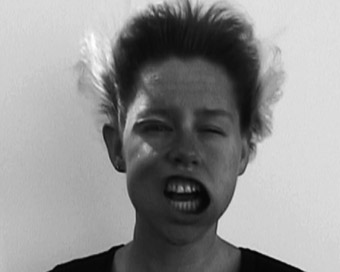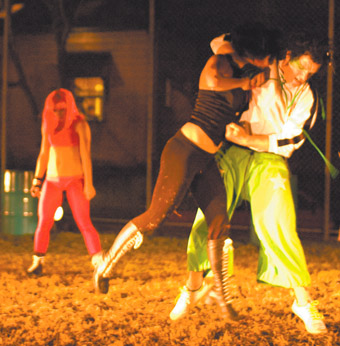Digital games, digital winners
Danni Zuvela looks at new media-driven awards & performances
Two recent shows in Brisbane highlighted the breadth and diversity of practice in the arena of digital culture. Innovation and some novel interpretations of interactivity figured in both The Harries: National Digital Art Award, and physical theatre company Zen Zen Zo’s latest show, Sub-Con Warrior 1.
The Harries National Digital Art Awards

Special Commendation, Janice Kuczkowski for Emperimentations in limits of tolerance #1
Founded last year, the Harries emerged from a unique partnership between the arts community and a branch of the Queensland Government, the Skills Development Centre. During the initial building of the Queensland Health-funded SDC, Arts Co-ordinator Jade Walsh says, as per Government policy, they were required to spend a percentage of building costs on art. “Being a centre for innovation, SDC staff decided that they could contribute more to the art community than by purely procuring art and decided to develop and coordinate an annual National Digital Art Award, with science being the link between health and art.” An advisory board of professionals from the arts community was established and 8 months later they launched the inaugural The Harries: National Digital Art Award. This year’s award attracted numerous entrants across a range of digital formats, awarding 3 prizes across the categories of static, dynamic and best emerging artist.
As you enter the dynamic (moving images) exhibition, to the right is a set of black cubes from which to view the videos. Frustratingly, these are only shown in excerpted form; however, even truncated, several works stood out. Trish Adams continued her delicate investigations into biomedical art originated from her own cells. Her Harries entry, the video Changing Fates (2006), like previous works, features time-lapse video-micrograph digital images of stem cells in Adams’ signature deep red, this time juxtaposed with material objects linked to Adams’ grandmother, Mollie—photographs, an elegantly inscribed fountain pen and writing samples. The concluding image, showing both Mollie’s portrait and the beating cluster of Adams’ stem cells (now cardiac cells), speaks poignantly about the cathexis of objects in family relations, while continuing Adams’ contribution to the contemporary conversation about such medical research.
Appropriately for a show that “aim(s) to be living proof of [the] art-science nexus”, biomedicine features in other works, including Michele Barker and Anna Munster’s Struck, a multi-channel video and sound installation exploring medical imaging. Featuring a ghostly figure on a blue-black background (resembling Magnetic Resonance Imaging) and intermittent white text referring to neurological damage and hysteria, Struck received the award for the Dynamic category ($8,000). While it does little to dispel the feeling that text on screen tends to detract from rather than enhance imagery, there are beautiful touches (the tendrils of white liquid unfurling in space and the complex layered soundtrack of muffled shrieks and gasps), and a clever connection with the popular obsession for medicalised, forensic displays of corporeality.
The back wall is given over to large multiple projections showing works in their entirety. Magda Matwiejews’ lush digital collage animation, Insect, is the most striking, which is fortunate, since its central position means it dominates the field of vision. Insect features a very beautiful young woman naked and floating through a series of Baroque tableaux on gossamer wings. Associations can be made to both the fruity imagery of Pipilotti Rist’s Homo sapiens sapiens installation and the darker, William Burroughs’ Naked Lunch side of human-insect relations as the key character mates with various plants and an amorous dragonfly.
Genevieve Staines’ interactive installation, Time Space Frames, was located in a small side room at the far end of the exhibition. As you approach, it appears as though the old-style single lens reflex camera is pointed at the wall, but peering through the viewfinder, we see that there is a hole in the wall, through which the video can be seen. The video features landmark Brisbane buildings ‘processed’ through a range of digitally animated architectural interventions; blinds, cracks, windows and bricks appear, then disappear. The integration of these techniques with the existing aesthetics of the buildings is seamless; the ‘new’ facades look real, if improbable. When the viewer depresses the button, the ‘shutter’ closes and re-opens (complete with shutter sound-effects) to reveal a different video sequence. Time Space Frames playfully collocates old and new technologies. Through the viewer’s ‘use’ of the old analogue camera to reconfigure urban landscapes, Staines reflects on the role of photography in ordering memory and perception and demonstrates a critical, exploratory approach to animation and interactivity. Staines won the Emerging Artist award ($2,000).
Linda Dement won the Static Prize ($8,000) for White Rose and Janice Kuczkowski received a Special Commendation and $1,500 for The Limits of Tolerance.
Zen Zen Zo

Katie Hollins, Carly Rees, Dave Sleswick, Sub-Con Warrior 1
photo Morgan Roberts
Katie Hollins, Carly Rees, Dave Sleswick, Sub-Con Warrior 1
The phone call came the morning of the show. “Hello Danni. This is Sub-Con Warrior Electra, contacting you on behalf of the Gamemaster. I have a few instructions for you…”
I was told to come early, dress warmly and wear comfortable shoes “as the terrain of the Sub-Con can be unpredictable.” Appetite whetted, I turned up to the secret location where I was greeted and ‘processed’ by eager Sub-Con cadets attired in the heights (or is it depths?) of geek-chic. A coach pulled up and disgorged a seemingly endless payload of excitable teenagers on excursion. The performers, clearly loving their roles as library nerds and chess club refugees, waxing lyrical about ‘the game’, were utterly charming and soon put the roiling mass at ease. Their impeccable role-playing and outfits—from spectacles bound with band-aids to lemon cashmere twin-sets, too-snug knitted vests over check shirts, pants cinched unhealthily high and sensible shoes—drew guffaws, and easily disarmed both sarcastic teenage comments (theirs) and evident discomfort (mine).
After some opening group callisthenics, we were herded into a hall where we heard from the Gamemaster (Rob Thwaites) and teams then self-selected based on the desired level of participation: Alpha (high participation and ‘danger’, perhaps surprisingly a hit with the teens) and Omega (low participation and ‘puzzle solving’—me and some bemused parents and teachers). We all donned yellow plastic raincoats (‘assimilation suits’), the purpose of which presently became clear. Entering the game proper (Sub-Con), we were faced with our opening challenge—to neutralise the fire spirit with ‘water fruits’ (water-filled balloons in fruity colours). From that splashy opening (unsurprisingly, another huge hit with teens), we were shepherded through a series of ‘worlds’ simulating those in computer games.
Our guides through these worlds (a carpark, an inner-city street, an apartment) were more spectacularly dressed characters, embodying classic computer-game clichés. In a fun twist, the high-tech blue-haired warrior, the dreamy prophet, the butch commando, and steely gladiator were all played by female actors who ramped up the burlesque and won hearts with cheeky attitudes and snappy dialogue. Hunter, the lantern-jawed commando replete with camouflage stripes and beret, complimented her ‘boys’, saying, “That’s hot!” (to much giggling) at every available opportunity. My guide, Asimov, was an energetic ‘scientist’ bedecked in forearm computer/telephone and chest-mounted video screen, which was integrated well into the performance (though I couldn’t help but be reminded of Charlotte Moorman and Nam June Paik’s TV-Bra antics).
Six other key characters emerged—warriors Rush (Katie Hollins), Spill (Dave Sleswick), Mercury (Carly Rees) and Frost (Kevin Kiernan-Molloy), the child, Andi (Aideen McCartney) and Big Boss (Co-director, Steven Mitchell Wright), who presided over proceedings with devastatingly acid camp. These, too, were instantly recognisable as assemblages of computer game clichés—the deadly black-clad vixen, the pink-haired flirt, the funky street warrior etc—and also played with great gusto and skill. Jagged haircuts and futuristic makeup held up well during exhilarating fight sequences. The opening contest, where participants chose their ‘fighter’ was both familiar and strange; as doubtless intended, it was just like playing Streetfighter with human characters. Only these were no ordinary humans. Zen Zen Zo is famous for the superb athleticism of its performers, and their impressive physical feats elicited gasps and cheers. We were herded into cars to shelter from a zombie attack (genuinely unnerving), and then led to another world where the interactivity extended into new territory—the introduction of a reality TV element. Some of the audience watched others perform challenging moves on closed circuit TV in a successful but underdeveloped experiment. This was only touched on in the 4 audience-performances on the night, but has further potential for expanding the boundaries of interactivity in physical theatre.
The attention to detail in the costumes, keenly observed gestures (eg the praying mantis-like back-and-front jig that signifies ‘waiting’ performed by many a computer game character) and comic repetition of character phrases, demonstrated a masterful engagement with game conventions. Though the Big Boss’s lightning fast comebacks visibly withered some of the more insistent attention-seekers, the teens’ general reaction was positive. To evoke genuine mirth rather than sarcastic sniggers in teens, as Sub-Con frequently did, is a genuine achievement; the sassy attitude and ironic play with these gaming stereotypes was perfectly pitched for this tough crowd (skimpy costumes and gorgeous girl and boy performers probably didn’t hurt either).
Sub-Con Warrior-1 is a dance between celebrating and critiquing computer game culture. The challenge of representing computer games in the ‘real’ world has been met with a production that takes the concept of ‘immersion’ literally. The lost-child narrative and some rather heavy-handed dialogue on the ethics of gaming brings the production into the murk of the media effects debate, which fortunately is leavened with frequent humour and the bonhomie of pantomime. The Directors’ Notes, by Lynne Bradley and Steven Mitchell Wright, point out that while there are disturbing phenomena related to computer game culture (such as the hikikomori or self-isolated in Japan), “it’s easy to be self-righteous…gaming represents a highly creative and educational space.” Elaborating that space to include interactive physical theatre, Zen Zen Zo has concocted a show oozing with enthusiasm and excitement, and created much anticipation for the 2007 re-staging.
The Harries-National Digital Art Award, Queensland Health Services,
www.sdc.qld.edu.au/harries.htm
Zen Zen Zo, IN THE RAW: Sub-Con Warrior 1, July 11-29
RealTime issue #74 Aug-Sept 2006 pg. 27






